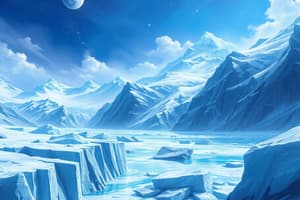Podcast
Questions and Answers
What is the primary role of ice sheets in regulating global sea levels?
What is the primary role of ice sheets in regulating global sea levels?
- Decreasing global sea temperatures
- Causing rapid rises in sea levels
- Stabilizing global sea levels (correct)
- Increasing ocean salinity levels
How would removing just one meter of ice from ice sheets affect global sea levels?
How would removing just one meter of ice from ice sheets affect global sea levels?
- It would cause a significant rise in sea levels globally
- It would raise ocean levels by nearly four centimeters (correct)
- It would lower sea levels by nearly four centimeters
- It would have no impact on sea levels
Which region has thicker ice layers according to the text?
Which region has thicker ice layers according to the text?
- North Pole
- West Antarctica (correct)
- Greenland
- Arctic Circle
How do ice sheets respond to changes in temperature according to the text?
How do ice sheets respond to changes in temperature according to the text?
What would be the impact on global sea levels if more ice were added to ice sheets?
What would be the impact on global sea levels if more ice were added to ice sheets?
Why are ice sheets particularly sensitive to increases in temperature?
Why are ice sheets particularly sensitive to increases in temperature?
Flashcards are hidden until you start studying
Study Notes
Cryosphere Overview
The cryosphere refers to the parts of Earth's surface where water is frozen into solid form—specifically ice. This includes ice sheets, glaciers, permafrost and snowfall. It also encompasses bodies of sea ice floating in polar oceans. These features serve as indicators of climate change because they exhibit different responses to changes in temperature. Ice sheets, which consist mostly of ice from melting glaciers, are particularly sensitive to any increase in temperatures; if global warming continues unchecked, some estimates suggest all the Earth's land-based ice could melt within several hundred years.
Ice Sheets
Ice sheets are vast accumulations of ice covering large sections of continents such as Antarctica and Greenland. They play a significant role in regulating global sea levels due to their immense size and weight. For instance, removing just one meter of ice would raise ocean levels by nearly four centimeters. However, this process works both ways: if more ice were added instead, it would lower sea level accordingly—and vice versa when the ice melts again.
The thickness of ice sheets varies depending on location, with areas like west Antarctica being very thick while other regions have much thinner layers. Some estimates predict that even small increases in temperature could cause rapid deterioration of these regions leading to dramatic effects on global sea rise. In addition to contributing to rising sea levels, ice sheet mass loss has been linked to increased rates of erosion along coastlines. As the ice retreats, sediment is exposed and can be washed away quickly, causing damage to infrastructure near coastal cities and towns.
In conclusion, understanding the behavior of ice sheets is crucial in assessing how human activities may alter the environment. While there are many factors influencing changes in our planet's cryosphere, keeping track of what happens to its major components - like ice sheets – provides important insights into potential future scenarios affecting us all.
Studying That Suits You
Use AI to generate personalized quizzes and flashcards to suit your learning preferences.




